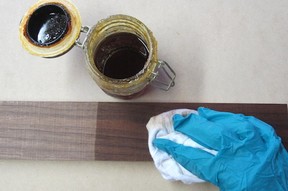How To Cleaning Wood Furniture Essential Oils
Furniture care Part 4: Oiling Wood Furniture

Reviews and recommendations are unbiased and products are independently selected. Postmedia may earn an affiliate commission from purchases fabricated through links on this folio.
What is truly spectacular about quality wood furniture is how the tones of the wood shift with each passing year. What tin can prevent enjoying this beautiful and natural development is the drying out of wood. As mentioned in previous posts of Furniture Intendance Tips (http://blogs.theprovince.com/2014/07/23/part-i-wood-furniture-care/), wood needs little maintenance. Furniture, when oiled and kept in the proper conditions, will probably non require re-oiling. Notwithstanding, if your pieces need re-oiling, it'southward a simple process and here you'll larn how to get those gems looking rich again!
If forest looks dusty and dull, or is cracking, it is likely also dry out. Drying out of wood can be the issue of furniture kept in constant direct sunlight, farthermost hot or common cold environments or nearly oestrus sources like radiators.
Types of Oil Finishes; Drying and Non-Drying Oils.
Drying oils are applied as a liquid to the wood and afterwards exposure to the air turn to a solid. The drying times vary but usually the more than natural the oil, the longer information technology will have to dry out. Good examples of this are boiled linseed oil and tung-oil. Danish Oil falls into the category of a drying oil, but information technology is really an oil and varnish mixture. The oil is what draws out the forest'due south natural dazzler and the varnish provides moderate surface protection.
Non-drying oils are natural oils such every bit vegetable oils (coconut, olive) or mineral oils that have nothing added to them to initiate a curing process. Considering the oil stays wet, it is considered a treatment and not a finish. Maybe you have noticed your cut boards or serving platters looking dry later on you lot accept washed them? This is probably due to a non-drying oil washing off with the soap and water. If this is the example, you volition want to keep some oil handy to wipe on the surface with a dry out fabric when the lath is dry out subsequently washing. If yous would like something more permanent, you can use hemp oil which is a drying oil and food safe.
Oil penetrates deep into wood. Equally a outcome, it does not sit on pinnacle and so information technology leaves a more translucent and natural feel and look compared to finishes which get out a surface pic similar a lacquer. The drawback to information technology seeping in and not sitting on the surface is that it offers little surface protection from h2o or scratches.
PROS
— Oils seep into the forest and accentuate the patterns and colours of the grain.
— Oils offering some protection from the varying furnishings of the environment.
— Oil finishes are a good option for people looking for a natural non glossy look.
— In their pure or raw form oils are non toxic natural materials.
— Oil finishes are easy to employ and easy to repair.
Cons
— Oil is absorbed into the wood so there is no surface protection against scuffing or scratching. Applying wax over the oil will add a minimal layer of surface protection.
— Liquids and rut easily damage oiled surfaces.
— When oiled finishes are old or stale, they can wait dull and need to be re-oiled to maintain their appearance.
Oil, similar any finishing handling highlights the wood quality. If the wood has scratches, dents, or imperfections the oil will get a spotlight to these problem areas! A finish does not hide flaws it highlights them. Below is an case of wood which has marks on it. You can see the vertical lines are harder to spot when the wood is left unfinished and more than visible one time the finish has been applied.

Yous volition want to audit your entire project for possible trouble areas before applying oil. A tip to spotting flaws is wet a cloth with a mineral spirit like turpentine or naphtha. Working in sections wipe the surface with the cloth. The mineral spirit with evaporate quickly but you will take a enough time to run into if the surface is in fact smoothen and fix to be oiled or if you demand to spend more than time preparing the surface area.
At present that you are fully educated on wood oils you can decide if oil is the right pick for your furniture! It is important to note that modernistic article of furniture and antique article of furniture often require different types of care. If you have antique furniture, it is best to starting time contact a professional person antique restorer to larn how to all-time care for your piece.
How to Oil Your Piece of furniture.
— Put on your prophylactic gloves and piece of work in a well ventilated expanse.
— Wet a make clean, non-abrasive cloth with a mineral spirit and rub over the woods surface to remove any wax.
— To make clean the surface, dampen a cloth with h2o and a non abrasive balmy soap such equally Spud's Oil Soap. If the woods looks wet your cloth is too wet.
— Let the surface to dry out completely.
— Gear up the surface using super-fine grade #0000 steel wool. Rub the steel wool in the direction of the grain and use light even pressure. A technique to identifying which way the grain is running is lightly rub your manus over the woods. The wood will feel smoother when going with the grain than confronting it.
— Now employ the oil of your choice equally directed by the manufacturer.

— Unless otherwise indicated in the directions, it is best to let the newly oiled furniture set for at least 24 hours.
— If the wood yet appears dry, you lot may re-apply oil.
— If you program to add wax, yous are ready to do so after the oil has fully cured.
Precautions
Some oils have solvents which are highly flammable and combustible. An exothermic reaction with air (oxidation) tin occur and cause oil soaked rags to go hot and beginning a fire. This is easy to avoid past merely washing the rag out with h2o, opening it up and laying it on a not-flammable surface to dry or store it in a metal container designed for such purposes. Dispose based on your local bylaws.
If you lot want to learn more than about finishes for wood, I recommend reading Bob Flexnor'south volume, Understanding Woods Finishing, second edition.
Give thanks you for reading,
xoxo Meredith Nicole
For more on what's happening in craft and design follow on twitter, Instagram and facebook!
Source: https://theprovince.com/life/furniture-care-part-4-oiling-wood-furniture
Posted by: scrogginsfrawing.blogspot.com



0 Response to "How To Cleaning Wood Furniture Essential Oils"
Post a Comment